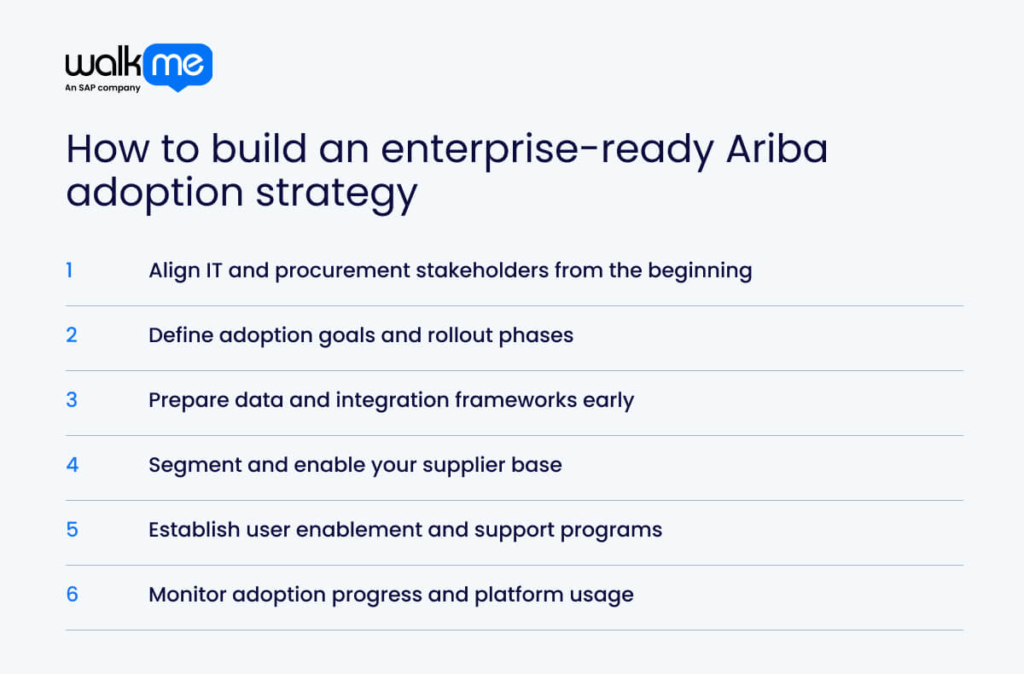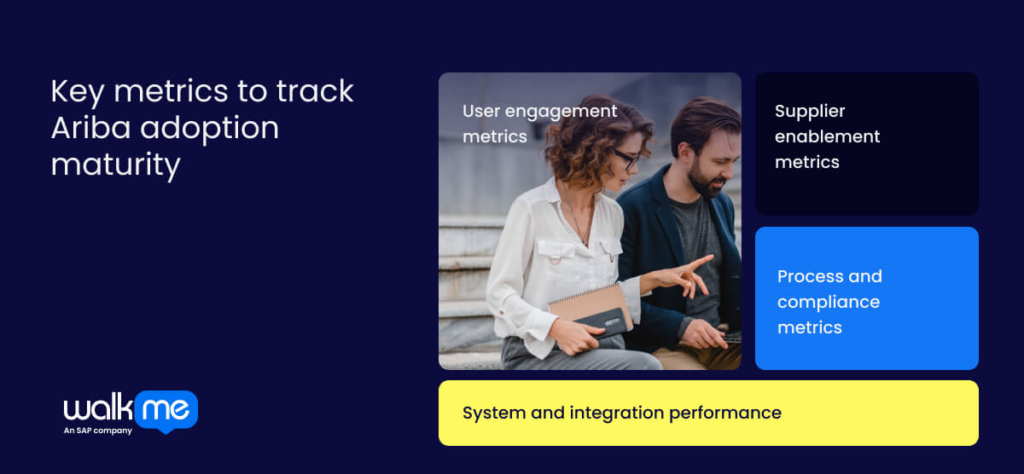Companies must continue to improve how they buy goods and services to save money and work more efficiently. Procurement begins when someone identifies a need and ends when the company makes payment to the supplier.
A well-run process helps teams manage spending and stay within budget. Teams also need to approve new suppliers quickly to respond to market changes without skipping checks or breaking rules.
Manual steps often lead to errors, such as duplicate orders or incorrect payments. Teams can reduce these mistakes and improve data accuracy by automating the process. SAP Ariba, a procure-to-pay platform, supports this automation.
But businesses must plan the digital adoption well. This guide shows what Ariba adoption is and why it matters. You will also get a structured roadmap for successfully adopting Ariba. Finally, it also explains the metrics needed to measure success.
What is Ariba adoption?
Ariba adoption is the process of helping employees and suppliers use SAP Ariba effectively in their daily work. Companies must provide employee training and clear guidance to build user confidence.
When users understand how to navigate the system and apply it to their workflows, they make better decisions and deliver greater value. Without strong adoption, businesses miss out on cost savings and process improvements.
As a platform, SAP Ariba offers cloud-based tools to manage sourcing, contracts, and spending. Companies can use it on its own, with SAP S/4HANA, or alongside tools like SAP Fieldglass and SAP Concur. Ariba gives real-time insights to help teams make smarter choices, reduce costs, and meet compliance and sustainability goals.
Users can manage budgets, track supplier performance, and improve procurement. This occurs with tools like guided buying, spend analysis, contract management, and ERP integration.
Why is Ariba adoption important?
Ariba adoption is important as it helps businesses improve procurement by automating tasks like sourcing, contracting, and ordering. Instead of relying on manual work, teams can save time and focus on higher-value activities.
Even more, Ariba provides a single platform where users can access information, submit requests, and track progress easily. The system guides users through procurement rules and reduces mistakes, fraud, or non-compliance.
Next, it also gives full visibility into spending, which helps teams find cost-saving opportunities and negotiate better deals. With better supplier collaboration and contract tracking, businesses can manage relationships more effectively.
Then, Ariba also offers tools to analyze spend data and monitor supplier performance, allowing teams to make smart, data-driven decisions. This network supports real-time communication with suppliers and lets teams track order statuses instantly.
How to build an enterprise-ready Ariba adoption strategy

To get the most out of SAP Ariba, your business needs a clear digital adoption strategy.
When you plan well, you gain user support and run the system effectively. Instead of just installing software, you build a digital culture that helps your team use Ariba to reach business goals.
Here are the steps you need to take for Ariba adoption:
Align IT and procurement stakeholders from the beginning
Involve key stakeholders early in the process. Form a cross-functional team to lead the SAP Ariba adoption rollout. Include people from IT, finance, accounts payable, vendor relations, and others who manage daily procurement tasks.
Gather feedback from each team about the upcoming changes. Understand their current challenges and what they need in the new tool. Use their input to shape the SAP Ariba setup and improve the overall adoption process.
Define adoption goals and rollout phases
Set clear goals before you begin your software adoption journey. Decide whether you want to reduce costs, boost flexibility, improve performance, or drive innovation. Use these goals to shape your strategy and guide your decisions. Align your cloud plan with your overall business goals to stay focused.
Then, break the Ariba adoption project into smaller, manageable stages. Assign clear objectives and tasks to each one. This approach helps you manage risk, avoid confusion, and keep progress steady. Plan each phase carefully to support a smooth rollout. By doing this, you help your team adjust faster and make full use of the new system.
Prepare data and integration frameworks early
To prepare for SAP Ariba, define your master data, transactional data, and data rules early. Map your current data to Ariba’s structure to keep it accurate. Build a collaborative team from IT, finance, and procurement to lead the project.
Furthermore, review your source-to-pay processes to find where Ariba can improve efficiency. List all system connections and plan how to link them to Ariba. Clean your data and set up rules to manage it. Create a data migration plan that includes extraction, transformation, and loading. Test all integrations and migrations thoroughly, and collect user feedback before the final launch.
Segment and enable your supplier base
To support Ariba adoption, start by grouping your suppliers by type, spend level, and importance. Use Ariba Supplier Lifecycle Management (SLP) to onboard new suppliers and update current ones.
Next, communicate clearly with suppliers about onboarding steps, expectations, and benefits. Train them based on their needs and guide them through Ariba’s tools. Use the supplier portal to share information and updates. Track supplier activity, such as order volume and invoice rates. Review performance data often and solve any issues quickly to keep suppliers engaged and productive.
Establish user enablement and support programs
Adopting Ariba cloud solutions requires a strong change management strategy to guide the transition. Clearly explain the benefits and updates to all stakeholders. Train employees based on their roles so they feel confident using SAP Ariba. For example, create onboarding paths for each group, such as marketing and finance, based on how they use the system.
Next, create interactive guides that walk users through key tasks, like onboarding a new supplier. In addition, offer ongoing support to solve issues quickly and keep teams engaged. When you address concerns early and provide the right training, your team will adopt the new system more quickly.
Monitor adoption progress and platform usage
Ariba adoption requires ongoing effort, not a one-time setup. Track system performance regularly to catch issues early and make improvements. Monitor how users interact with SAP Ariba to find ways to improve workflows and the user experience. Analyze user behavior and event data to help IT teams make smart changes and build better in-app experiences.
In addition, watch usage and costs closely to manage resources and lower expenses. Use these insights to increase ROI and keep your system running smoothly. More importantly, stay up to date with SAP updates and features to get the most value from your tools.
Key metrics to track Ariba adoption maturity

Track SAP Ariba maturity with clear metrics to measure how well the system works. You can then use data to improve processes and make better decisions.
Monitor these metrics to identify gaps, reduce costs, and improve procurement:
User engagement metrics
User engagement metrics show how people interact with a product or service. These metrics include session duration, time spent on each page, engagement rate, and feature usage. For instance, session duration shows how long users stay during a visit, while time on page reveals interest in specific content.
Next, the engagement rate measures how many users interact with the platform. Alternatively, feature usage shows which aspects of the Ariba platform users rely on most. By tracking these numbers, teams can see what works and spot areas that need improvement. All in all, these metrics help make better decisions to meet user needs and support business goals.
Supplier enablement metrics
Supplier engagement metrics help you measure how well suppliers meet your business needs. When you track these metrics often, you can spot issues early and improve your supplier relationships. First, focus on quality by checking defect rates, product accuracy, and customer delight.
Next, review delivery by tracking on-time rates and lead time accuracy. Watch costs through pricing, savings, and total cost of ownership. Measure relationship strength by looking at communication, responsiveness, and teamwork. Don’t forget to track sustainability efforts and supply chain risks to get a full view of performance.
Process and compliance metrics
Process and compliance metrics let you measure how well your business runs and follows rules. Use process metrics to track steps, find delays, and spot errors in your daily tasks. Fewer steps and lower error rates often mean better operations.
Use compliance metrics to check how often employees break rules or skip required actions. Track training completion rates to make sure your team understands the rules. When you monitor these numbers, you can identify and fix issues early, keeping your operations on track. These metrics give you the insight you need to improve performance and reduce business risks.
System and integration performance
System performance metrics show how well each part of your system works. Monitor system uptime to see how long it runs without stopping, which shows its reliability. Measure error rates to determine how often problems occur so that you can fix them quickly.
Integration performance metrics focus on how well your systems work together. Measure performance to check the speed and efficiency of data sharing between systems. Track Mean Time to Recovery (MTTR) to see how fast your team restores the system after a failure. These metrics help you spot issues and improve performance.
Transform your enterprise with a better Ariba adoption plan
As procurement becomes more complex, employees often choose the wrong tools, leading to unapproved and risky spending. This puts pressure on procurement teams to control costs and reduce risk. Ariba adoption can help by making procurement easier, improving supplier relationships, and cutting costs—if teams use it properly.
To enable a strategic adoption, start by reviewing your procurement needs and setting clear goals. Work with teams like IT and finance to build support and capture requirements. Train your employees to use SAP Ariba confidently. Use clear communication and offer ongoing support to guide them through the change. With strong planning and teamwork, your organization can fully adopt SAP Ariba and improve procurement processes.
FAQs
SAP Ariba helps businesses cut costs, track spending, manage suppliers, and reduce risks. It also improves efficiency and strengthens the supply chain.
SAP offers both Ariba and S/4HANA for different needs. Ariba focuses on sourcing and supplier management. S/4HANA runs core business tasks, including procurement.

